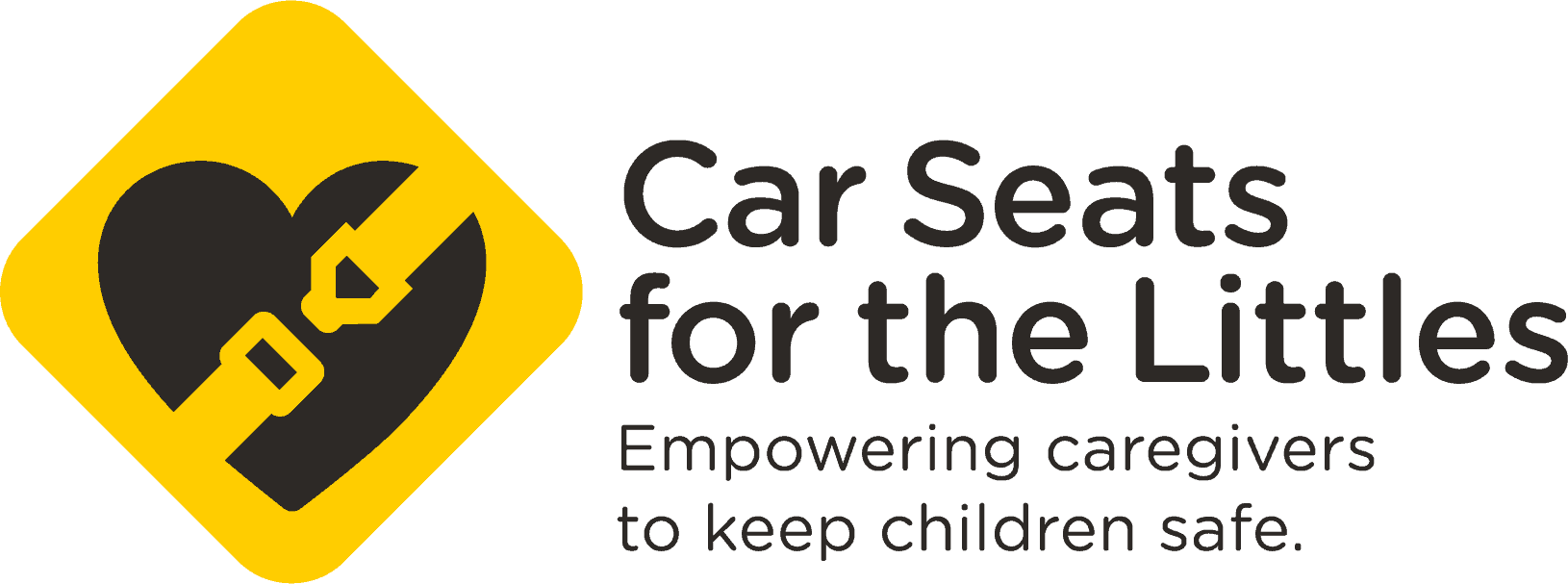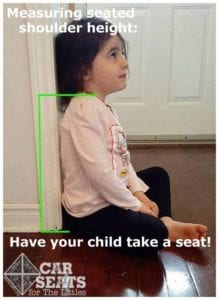Car seats have more than a few limits for the child who rides in them. They have minimum height, weight and fit minimum limits along with maximum height, weight and fit limits. When our users and readers are shopping for your child’s next car seat or trying to determine if a child has outgrown a car seat, they often ask for advice on measuring children for car seat fitting. Measuring Littles for car seats differs somewhat from the way that your doctor measures your kids, so we’ve outlined some techniques to help make that process easier.
Height

Measuring standing height
All car seats and booster seats have standing height limits. The best way to measure your child’s standing height is to have them stand straight against the wall in socks or bare feet. Place a book on their head (held parallel to the ground against the wall) while you make a quick mark on the bottom of the book to mark their height (use pencil if you don’t want a permanent mark on your wall). Measure the distance between the floor and mark to get an accurate standing height of your child.
Babies are often measured while lying down during doctor appointments. While this is acceptable for those appointments, we have found that lying down measurements can often vary a few inches from the child’s standing height. Even if it takes two people, a standing height is the most accurate measurement for babies as well.
This is only necessary when the child is nearing the height limit of their car seat.
Weight
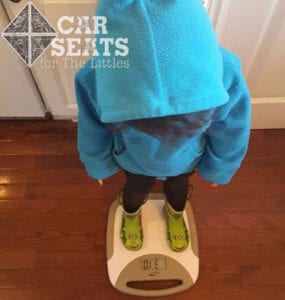
Measuring car seat weight — fully clothed and with shoes on!
The weight limit of a car seat is the weight of the child fully dressed — including their boots, light weight outerwear, and anything else they will be wearing in the vehicle. Since the weight of a child at their doctor’s office is generally their naked weight, babies especially, a quick at-home weight check is recommended if your child is nearing the weight limit of their seat. If the seats’s weight limit is 40 lbs and your child weighs 39 lbs fully dressed and fully fed, then the seat is not yet outgrown – but it may be time to consider the next step. That may be to a longer lasting rear facing or forward facing car seat, or from one stage of car seat to another.
Fit
Rear Facing Shell Height Limits
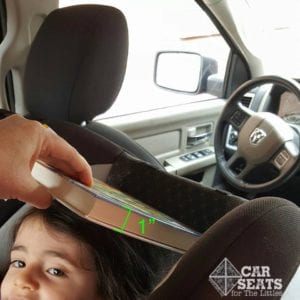
Using a book to measure height
Some car seats require that a certain amount of the seat’s shell be above the child’s head when the child rides rear facing. Some car seats do not – always check your manual to determine the requirement. For seats with this requirement, instead of measuring the child’s seated height, you can measure how much shell is above the child’s head while they are sitting in their car seat. With the seat installed and the child strapped in, find a 1″ thick (or 1.5″ thick for seats that require 1.5″ of shell above the head) book and place it on the child’s head. Hold the book perpendicular to the car seat’s shell. The book should not be parallel to the ground. If there is seat shell showing above the upper edge of the book, the child fits in the seat. If there is no shell above the upper edge of the book, the seat is outgrown rear facing.
Forward Facing Harness Height Limits
Forward facing car seats require that the harness straps be at or above the child’s shoulders. Booster seats also position the seat belt above the child’s shoulders. For these types of car seats, a seated torso measurement can help determine if a particular car seat is a good choice for the child in question.
To measure seated torso height: have the child sit with their legs crossed, criss cross applesauce style against a wall. With a pencil, mark where the top of their shoulder meets the wall. If you measure floor to the mark you now have your child’s torso height.
Many rear facing car seats state a seated height limit. Torso height is the distance between the child’s bum and shoulder and seated height is the distance between the child’s bum and the top of their head. To measure your Little’s seated height you will use the same method as torso height, but make a mark at the top of the child’s head instead of at the child’s shoulder. Use a book to aid with marking the spot on the wall if needed.
Why Torso Height Matters
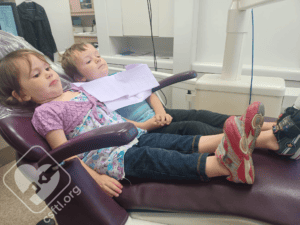
The 2 year old child on the left has almost the same torso height as the 4 year old child on the right, despite the 4 year old being 4 inches taller in standing height.
Some people carry their height in their legs whereas some carry it in their torso. A child with a long torso will need higher harness heights and belt guides than a child with a short torso. This also means children with long torso sometimes outgrown harnessed seats and high back boosters before their peers with short or averaged sized torsos.
In Summary
Kids grow quickly and getting your little to sit still long enough for an accurate measurement may be costly to a parent’s sanity at the time, but having accurate measurements will save future insanity by giving you the information needed to choose the best seat for your child.
